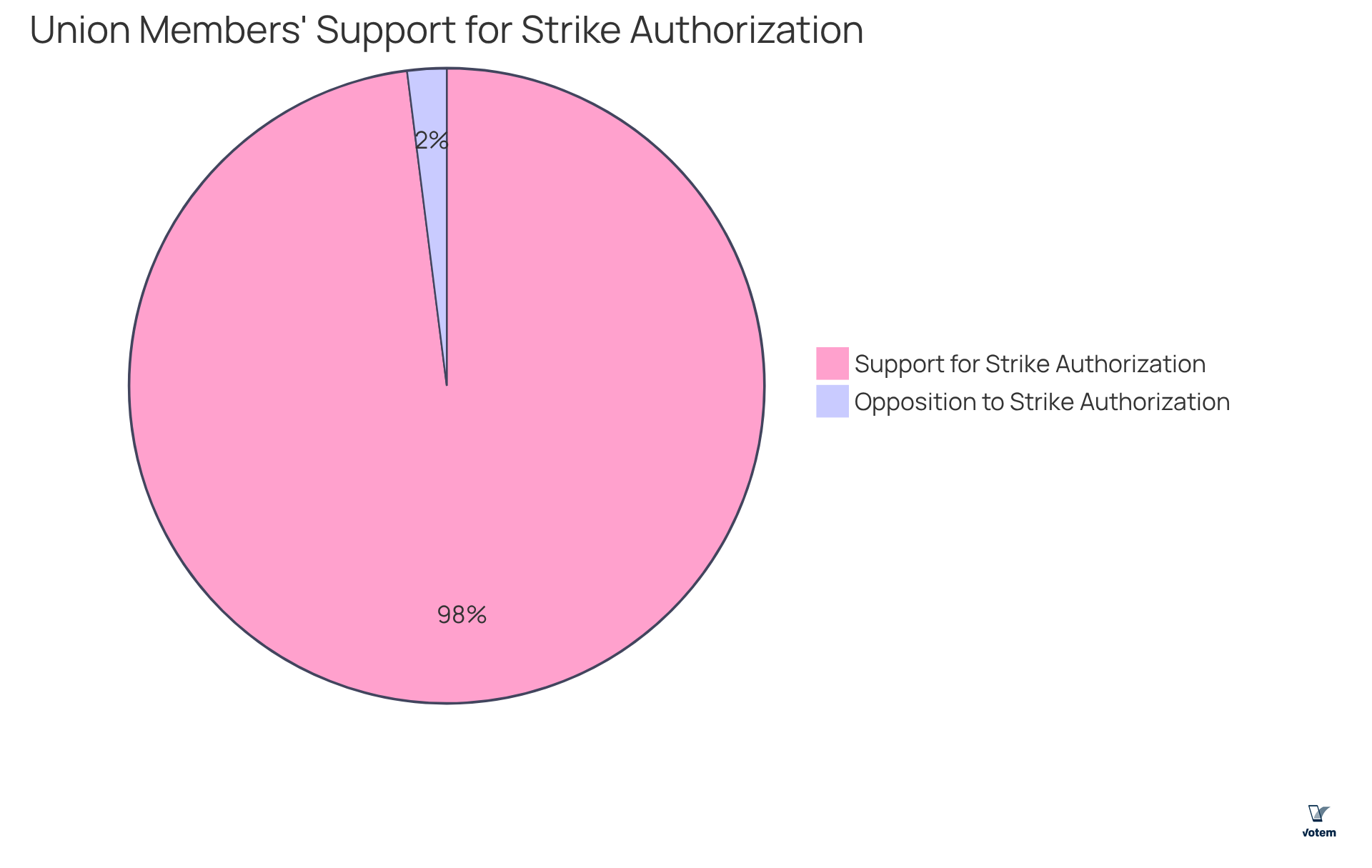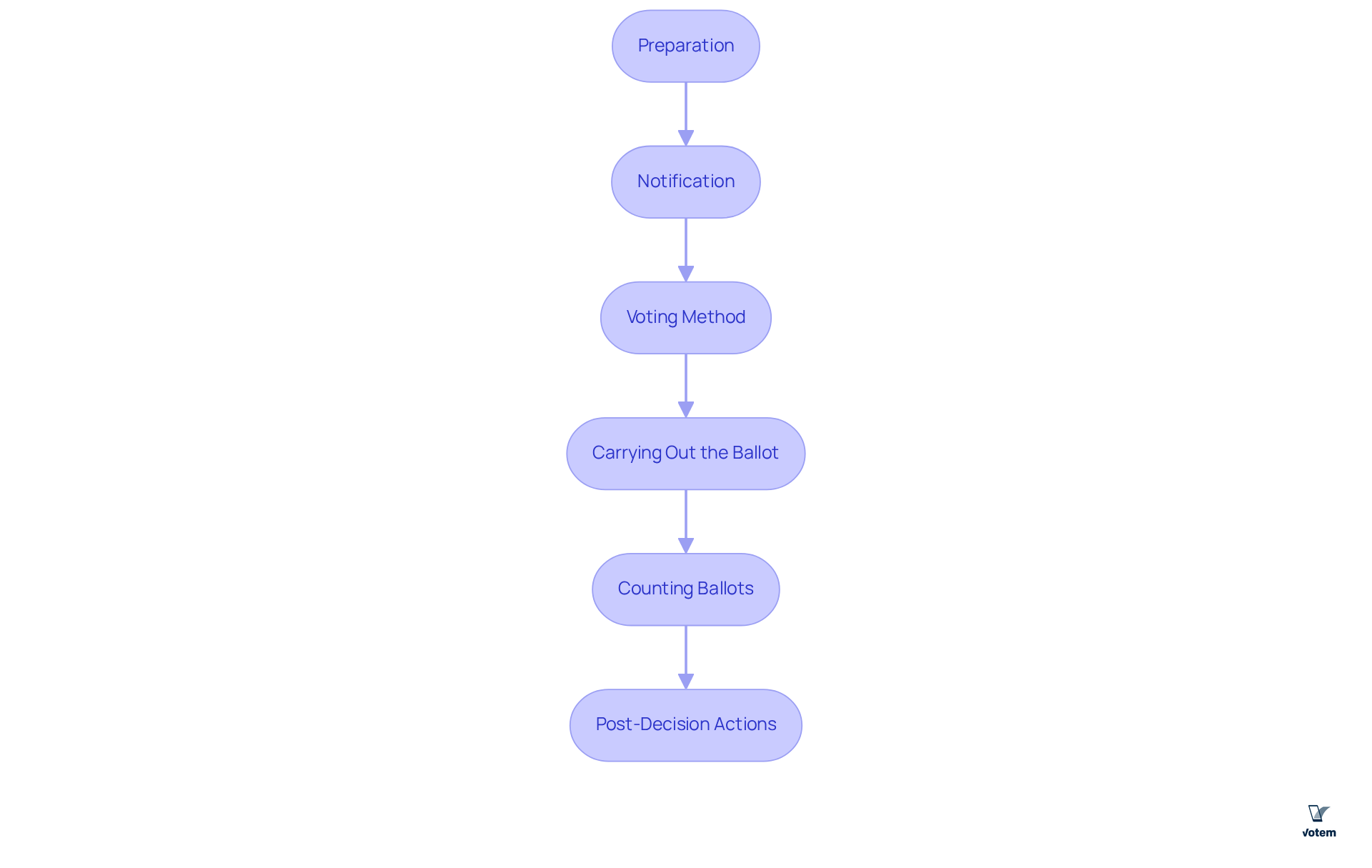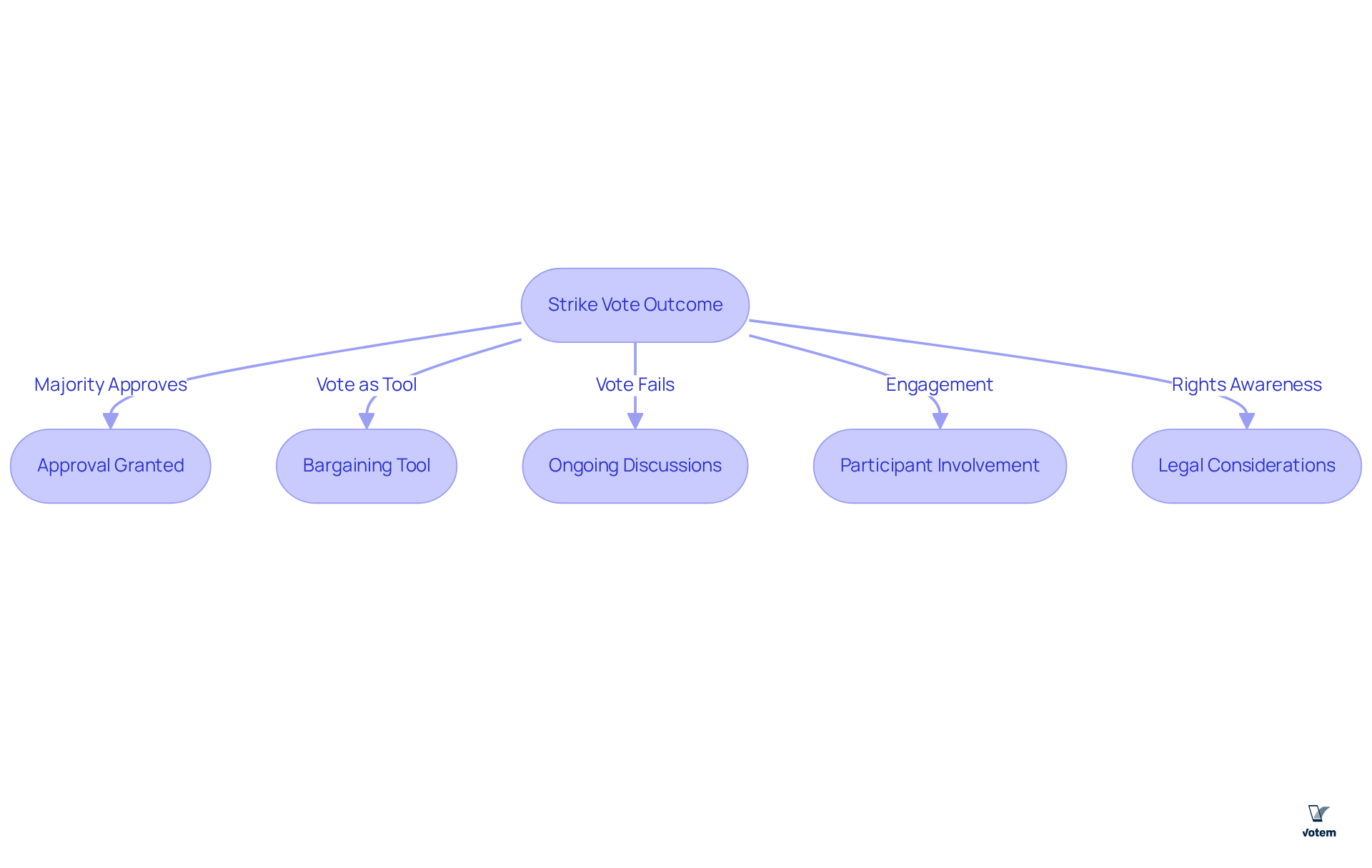Overview
The article outlines the fundamental steps and outcomes of a strike vote, underscoring its role as a crucial mechanism for union members to collectively decide on authorizing a work stoppage. This process not only showcases solidarity among workers—illustrated by high approval rates in recent votes—but also functions as a strategic instrument in negotiations with employers. Such unity can lead to enhanced working conditions and increased wages.
Furthermore, the significance of a strike vote extends beyond mere decision-making; it serves as a powerful statement of collective strength. With workers united, the potential for impactful negotiations rises, compelling employers to reconsider their positions. As demonstrated in recent cases, high approval rates signal a robust willingness among union members to take decisive action, fostering an environment conducive to change.
In conclusion, the strike vote is not merely a procedural step; it is a vital tool that empowers union leadership and enhances the bargaining power of workers. By understanding and effectively utilizing this process, union leaders can navigate the complexities of negotiations with confidence, ultimately striving for better outcomes for all members.
Introduction
A work stoppage ballot transcends mere procedural formality; it signifies a pivotal juncture in labor relations where collective voices resonate powerfully. Understanding the strike vote process empowers union members to leverage their collective strength, influencing negotiations and advocating for their rights. However, what transpires when the results of such a vote are revealed? Will the unity displayed yield tangible outcomes, or will it merely underscore the persistent challenges in labor negotiations? This article explores the essential steps in conducting a strike vote, the significance of its outcomes, and the implications for both workers and unions alike.
Define the Strike Vote: Purpose and Importance
A work stoppage ballot is a crucial process through which union members collectively decide whether to empower their leadership to initiate a work stoppage. This formal procedure not only reflects the unified stance of the members but also guarantees that any decision to take action is backed by a majority.
The significance of a work stoppage ballot transcends mere numbers; it serves as a powerful demonstration of unity among employees, signaling to employers the seriousness of their demands and establishing a legal foundation for potential labor actions. Importantly, this decision does not allow for immediate action but grants leadership the authority to act if negotiations falter. By engaging in this process, workers assert their influence in critical decisions that affect their working conditions and rights.
For instance, in a recent strike vote, an impressive 98 percent of Starbucks collective members supported the authorization of the strike, underscoring their collective determination to address unresolved unfair labor practices. Such overwhelming support strengthens the organization’s negotiating position and empowers individuals to advocate for enhanced wages and working conditions.
Votem’s innovative further streamline this process by ensuring greater accessibility for all eligible voters, including military personnel and individuals with disabilities. As Linda McCulloch remarked, ‘Implementing Votem’s new, modern system which allowed greater access for all qualified voters was my greatest accomplishment in office.’
Moreover, utilizing Votem’s secure online platform can potentially triple voter turnout on launch day, significantly boosting participation in the voting process. Ultimately, ballot decisions exemplify the democratic principles that underpin union representation, ensuring that every individual’s voice contributes to the pursuit of equitable labor practices.

Outline the Strike Vote Process: Step-by-Step Guide
- Preparation: Union leadership begins by assessing the necessity of a ballot, taking into account current negotiations and the sentiments of the constituents. This initial evaluation may involve gathering feedback through surveys or meetings to accurately gauge the collective stance of the membership.
- Notification: It is imperative that members are informed about the forthcoming strike vote, including the rationale behind it, potential implications of a strike, and the voting process itself. Effective communication is essential to enhance participation and ensure that all members comprehend the stakes involved.
- Voting Method: Choosing the appropriate voting method—whether in-person, mail-in, or electronic—is crucial. The selected method should align with the needs of the membership while adhering to legal requirements and union bylaws. For example, Votem‘s CastIron platform facilitates secure online voting, thereby enhancing accessibility and compliance with regulations.
- Carrying Out the Ballot: The ballot process must be conducted in a manner that allows participants to express their preferences privately. Ensuring a transparent and secure voting process, such as a strike vote, is vital for maintaining trust among members and fostering confidence in the integrity of the electoral process.
- Counting Ballots: Once the polling period concludes, the ballots are counted, and results are communicated to the membership. Typically, a simple majority (more than 50%) is required to , underscoring the importance of clear and timely reporting.
- Post-Decision Actions: Should the outcome be favorable, union leadership must be prepared to initiate a work stoppage if necessary. Conversely, if the decision does not succeed, leadership may need to reassess strategies and continue negotiations, ensuring that member concerns remain a priority throughout the process.

Analyze the Outcomes: What Happens After a Strike Vote
Following a strike vote, several significant outcomes may unfold:
- Approval Granted: When a majority agrees, labor leadership gains the authority to initiate a work stoppage if negotiations falter. This outcome greatly enhances the union’s bargaining power, often resulting in more favorable terms. For instance, the AFSCME District Council 33 recently secured a contract after a work stoppage decision, culminating in a 14% wage increase over four years—the largest single-term pay rise in over three decades. A total of 2,375 votes were counted, with 1,535 in favor and 838 against, showcasing robust member engagement in the process.
- The act of a strike vote for a work stoppage serves as a potent bargaining tool. Employers may be compelled to reassess their positions to avert a work halt, as evidenced in the recent discussions involving District Council 33, where the potential for labor action influenced the city’s wage proposals. District Council 33 President Greg Boulware remarked, “Your organization stood up and fought for you, and we did the best we could with the circumstances we faced.”
- Ongoing Discussions: If the ballot does not succeed, the collective can persist in negotiations with the employer. This may involve exploring various strategies to address constituents’ concerns, ensuring that the organization remains proactive in advocating for its members’ interests.
- Participant Involvement: Regardless of the outcome, the polling process fosters increased participant involvement and unity. It cultivates a stronger union culture, as members actively engage in decision-making that impacts their livelihoods.
- Legal Considerations: Understanding the is essential. This encompasses protections for striking workers, such as the right to strike without retaliation, along with the potential repercussions of unauthorized strikes. Members must be well-informed about their rights and responsibilities throughout this process to effectively navigate any challenges.

Conclusion
Mastering the strike vote is an essential tool for union members determined to assert their collective power in labor negotiations. This formal mechanism not only reflects workforce unity but also establishes a foundation for effective action when necessary. Empowering leadership through a successful strike vote demonstrates the seriousness of workers’ demands and creates a strong legal basis for potential labor actions.
The article outlines the key steps of the strike vote process, from preparation and notification to the actual voting and subsequent actions. Each phase is crucial for ensuring members are informed, engaged, and prepared to make decisions that impact their working conditions. The outcomes of these votes can significantly influence negotiations; recent examples illustrate how overwhelming support has led to substantial wage increases and improved working conditions.
Ultimately, the significance of the strike vote transcends immediate results; it cultivates a culture of involvement and solidarity among union members. By participating in this democratic process, workers advocate for their rights and strengthen their collective voice in the workplace. Engaging in a strike vote is not merely a procedural step; it is a powerful assertion of unity that can lead to meaningful change in labor relations.
Frequently Asked Questions
What is a work stoppage ballot?
A work stoppage ballot is a formal process through which union members collectively decide whether to authorize their leadership to initiate a work stoppage.
Why is a work stoppage ballot important?
It is important because it demonstrates unity among employees, signals the seriousness of their demands to employers, and establishes a legal foundation for potential labor actions. It also ensures that any decision to take action is backed by a majority.
Does a work stoppage ballot allow for immediate action?
No, a work stoppage ballot does not allow for immediate action; it grants leadership the authority to act if negotiations fail.
How does a work stoppage ballot empower workers?
By participating in this process, workers assert their influence in critical decisions that affect their working conditions and rights.
Can you provide an example of a recent strike vote?
In a recent strike vote, 98 percent of Starbucks collective members supported the authorization of the strike, showcasing their determination to address unresolved unfair labor practices.
What role does Votem play in the voting process?
Votem provides innovative online voting solutions that enhance accessibility for all eligible voters, including military personnel and individuals with disabilities, potentially increasing voter turnout.
What impact can Votem’s online platform have on voter participation?
Utilizing Votem’s secure online platform can potentially triple voter turnout on launch day, significantly boosting participation in the voting process.
How do ballot decisions reflect democratic principles in union representation?
Ballot decisions exemplify democratic principles by ensuring that every individual’s voice contributes to the pursuit of equitable labor practices.
List of Sources
- Define the Strike Vote: Purpose and Importance
- Starbucks union workers vote 98% to authorize strike (https://freepressokc.com/starbucks-union-workers-vote-98-to-authorize-strike)
- MUNFA Strike Vote FAQs (https://munfa.ca/agreements_type/strike-vote-faqs)
- How does a union strike vote work? (https://surveyandballotsystems.com/blog/video-blog/how-does-a-union-strike-vote-work)
- Union representing blue collar Philly workers votes to authorize strike (https://whyy.org/articles/council-33-philadelphia-city-works-authorize-strike)
- Outline the Strike Vote Process: Step-by-Step Guide
- 94% of Benton County union members vote to strike, citing unfair wages and safety (https://kcby.com/news/local/94-of-benton-county-union-members-vote-to-strike-citing-unfair-wages-and-safety)
- The Strike Vote Authorization Continues! (https://unitedafa.org/news/the-strike-vote-authorization-continues)
- How does a union strike vote work? (https://surveyandballotsystems.com/blog/video-blog/how-does-a-union-strike-vote-work)
- Kaleida workers cast ballots in strike authorization vote (https://wgrz.com/article/news/local/kaleida-workers-cast-ballots-in-strike-authorization-vote-health-money-workers/71-ef8df1be-b732-44cf-9ee5-3d7930b201cb)
- Thousands of UC Employees Vote to Strike Amid Federal Funding Threats | KQED (https://kqed.org/news/12027153/uc-workers-vote-to-strike-amid-federal-funding-threats)
- Analyze the Outcomes: What Happens After a Strike Vote
- After 8-day strike, Philly’s blue-collar union approves new contract (https://whyy.org/articles/philadelphia-dc33-union-contract-vote)
- District Council 33 votes to ratify new contract with City of Philadelphia (https://fox29.com/news/district-council-33-announce-results-tentative-contract-vote)
- District Council 33 approves new contract with Philadelphia (https://nbcphiladelphia.com/news/local/district-council-33-set-to-reveal-results-of-ratification-vote-on-monday/4237860)
- IAM Union Members at Pratt & Whitney in Connecticut Achieve Contract Victory, Ending Three-Week Strike – IAM Union (https://goiam.org/news/iam-union-workers-at-pratt-whitney-in-connecticut-achieve-contract-victory-ending-three-week-strike)
- Ralphs/Albertsons Negotiations Updates 2025 (https://ufcw324.org/ralphsalbertsons-2025-updates)

